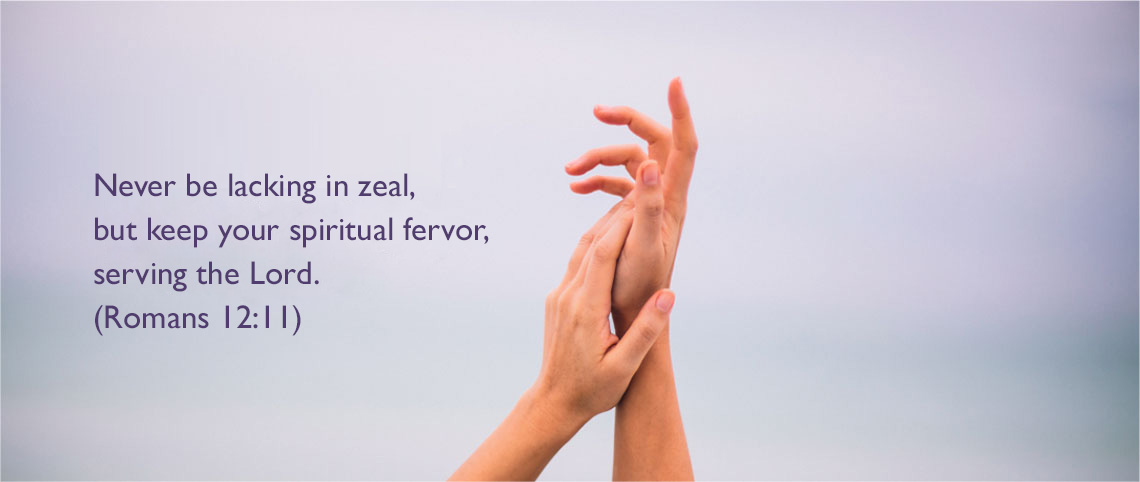Կը Սպասենք՝ Հաւատքով - Եբր.11.1,2
The Family Retreat of the Armenian Evangelical Emmanuel Church
The Family Retreat of the Armenian Evangelical Emmanuel Church took place in Dhour Shweir, from 24 July till 26 June. The main theme was "Who will separate us from Christ's Love?", presented by Ms. Sonia Sislian.
On Friday, 24 June afternoon, the families, kids, young men and women, adults were in the church playground to head to the Arab Evangelical Camp center, in Dhour Shoueir. Ms. Vartoug Balekjian led the opening worship time. The guest speaker, Ms. Sonia Sislian presented the main theme of the retreat.
On Saturday, 25 June, the participants had their quiet time with God, after which they had worship time, led by Ms. Ani Baboghlanian.
The first session of the guest speaker entitled "To Love, to marry and ... to divorce", that the marriage was between Adam and Eve, that God joins and Satan divides. The subject was discussed further in 4 groups.
After having lunch, the second session was entitled "To Love, to Marry and ... to Renew our Vow with Christ", that Christ is the church's groom, He loves us greatly.
After dinner, Mr. Manoug Ibitian and Mr. Anto Ovigian led the social and fun time, as well as Armenian sing songs.
On Sunday morning, the worship time was led by Mr. Levon Bedigian. After having lunch and taking group photos, we headed back to the premises of the Armenian Evangelical Emmanuel Church.
The organizing commitee members were: Ms. Vartoug Balekjian, Mr. Manoug Ibitian, Ms. Ani Baboghlanian, Mr. Sam Demirjian.
The leaders of the discussion groups were: Ms. Vartoug Balekjian, Mr. Manoug Ibitian, Ms. Houry Barsoumian, Mrs. Vera Svajian.
Present were 38 members and 11 children.
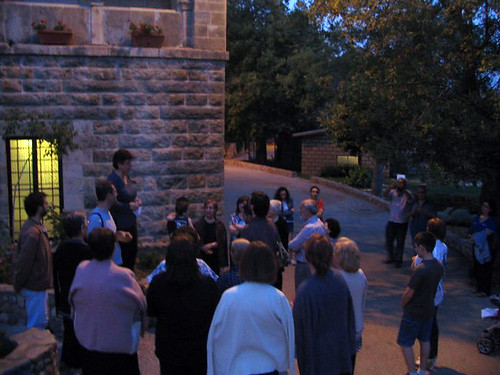
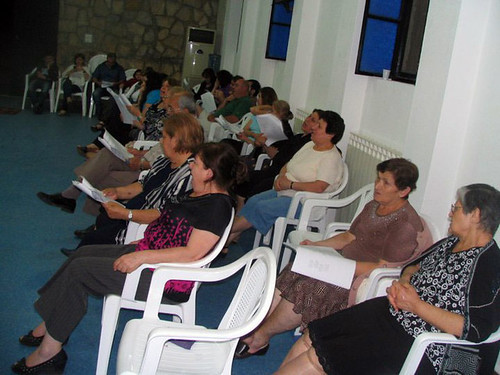

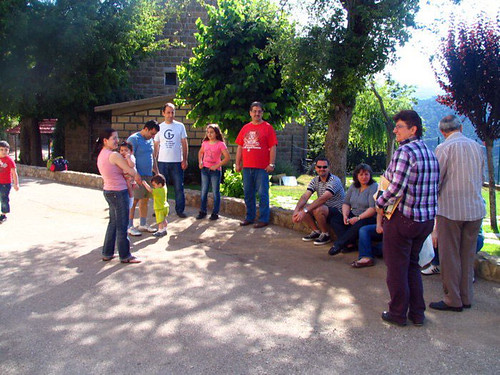
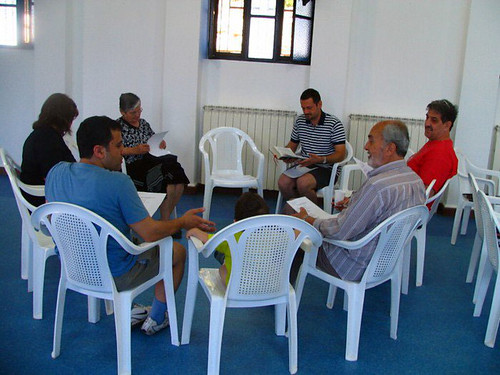
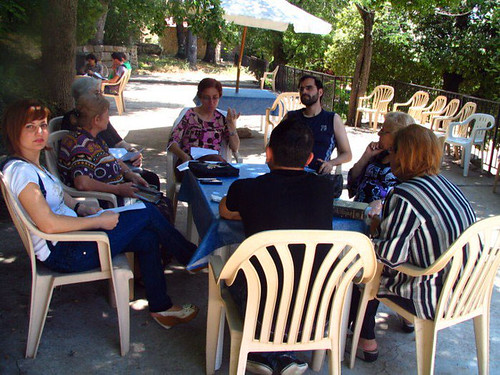
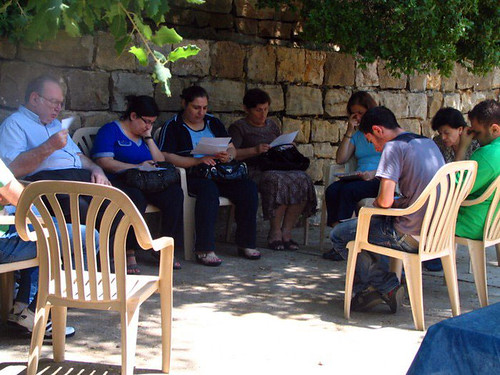

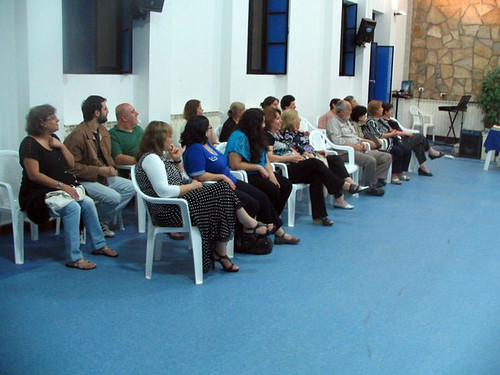

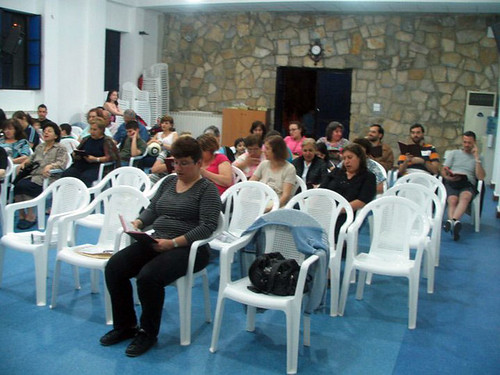
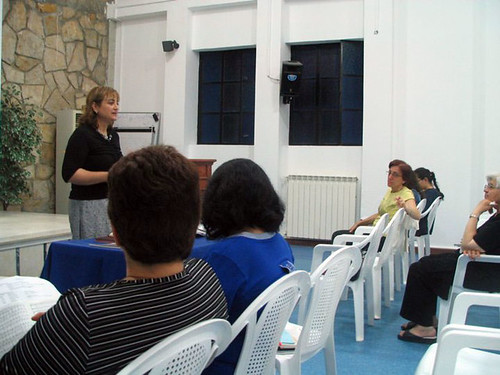
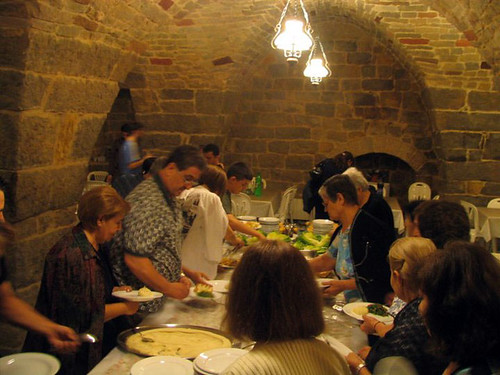
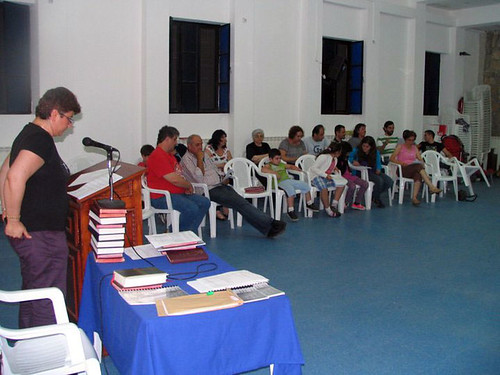
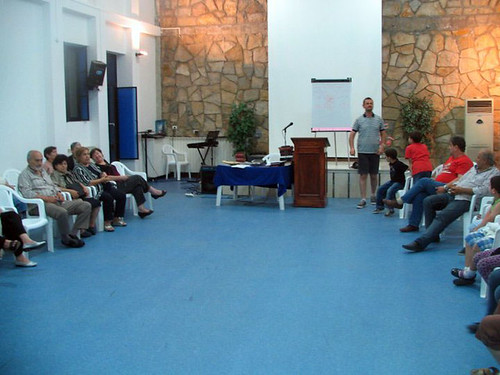
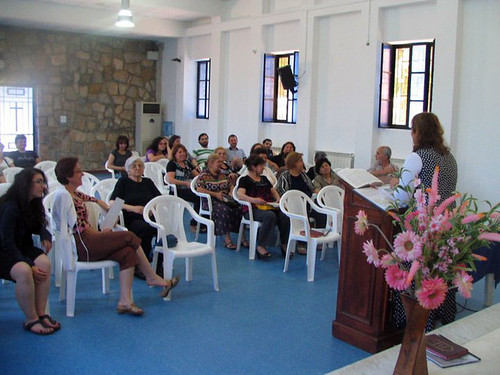
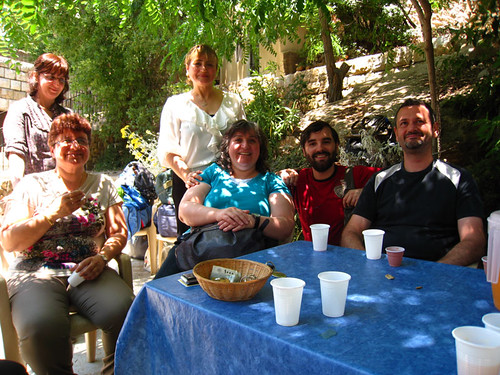
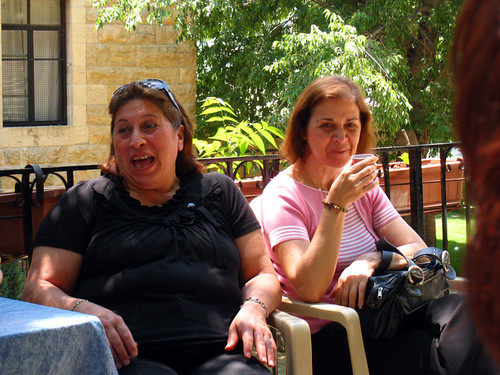
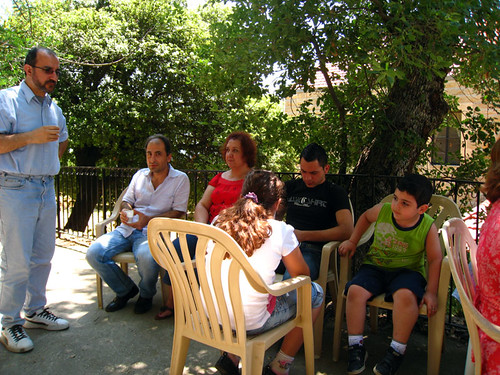
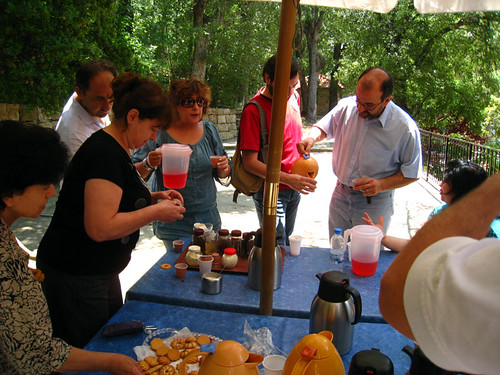
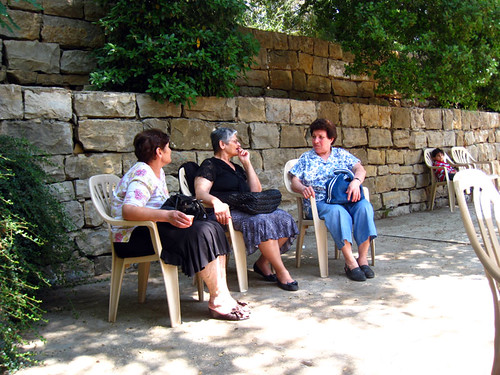
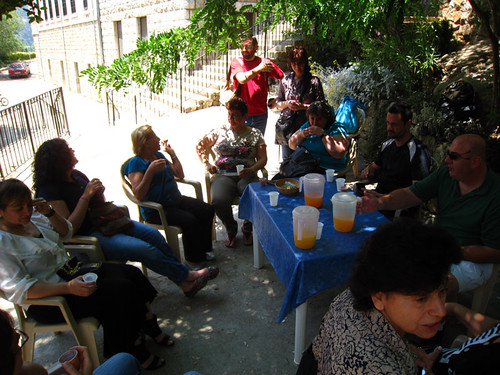
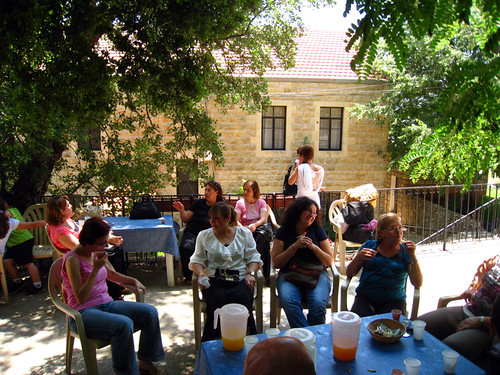
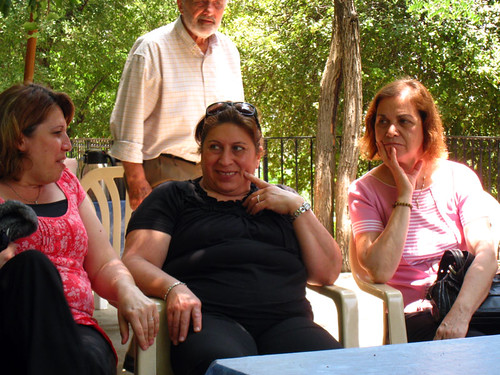
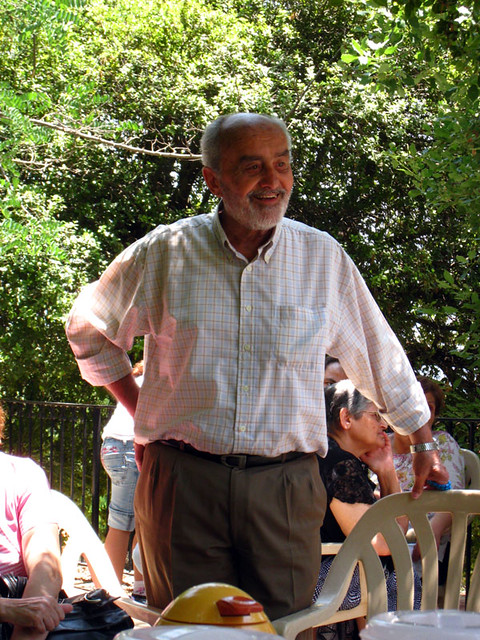
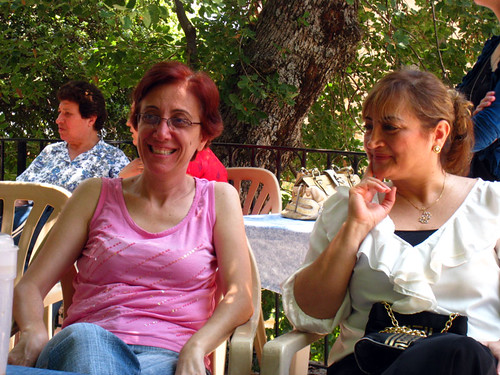

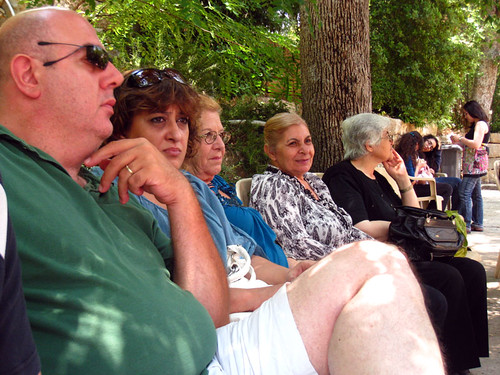
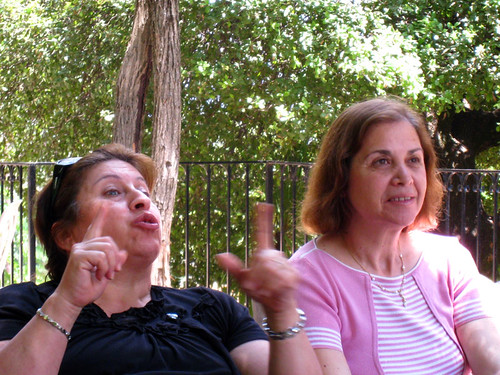
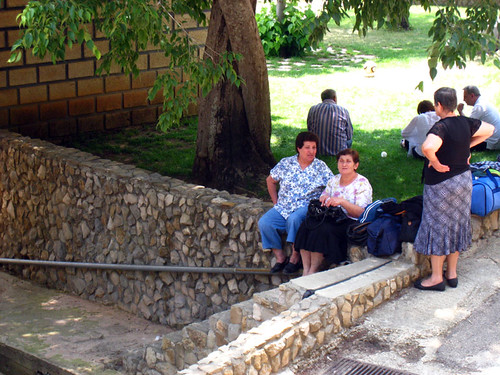
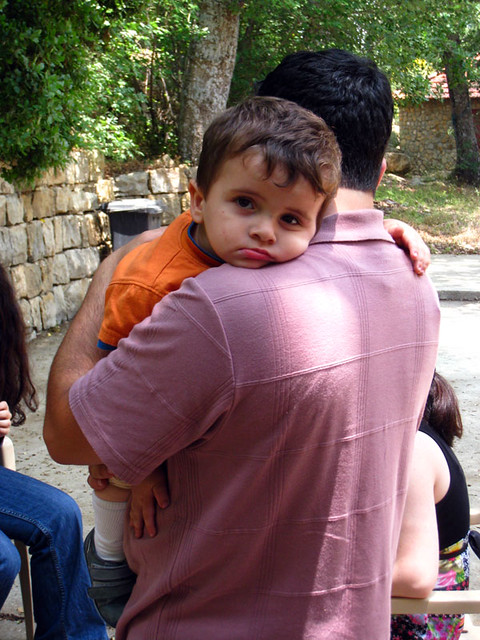
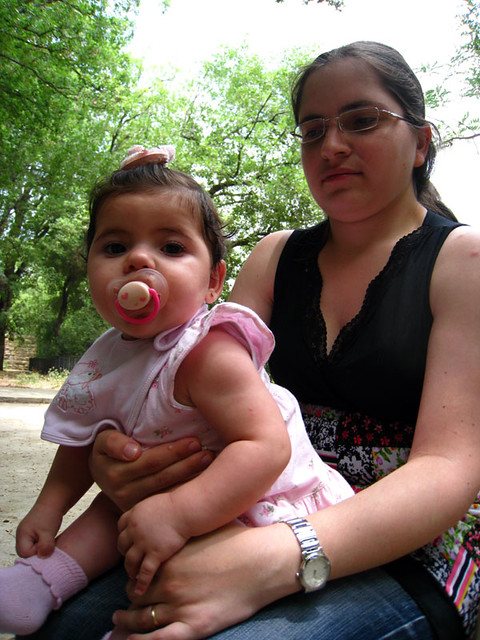
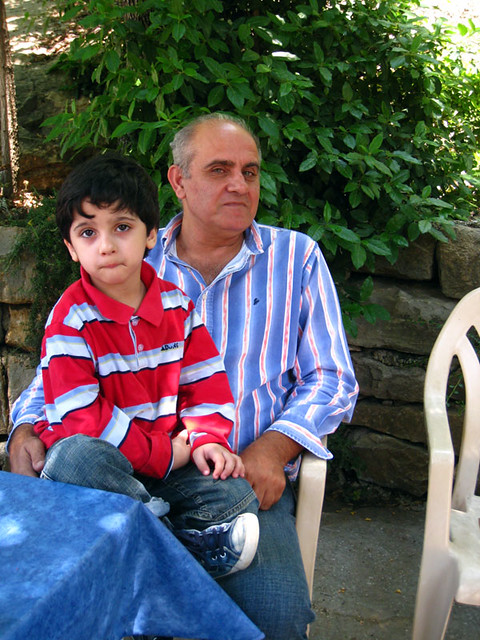
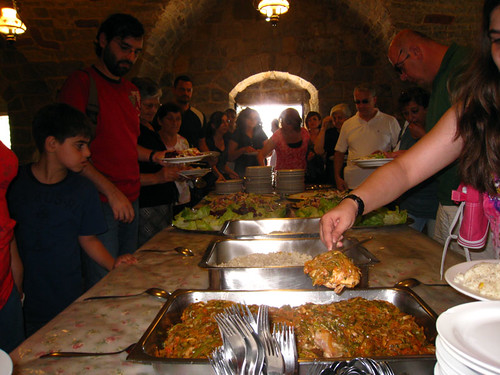
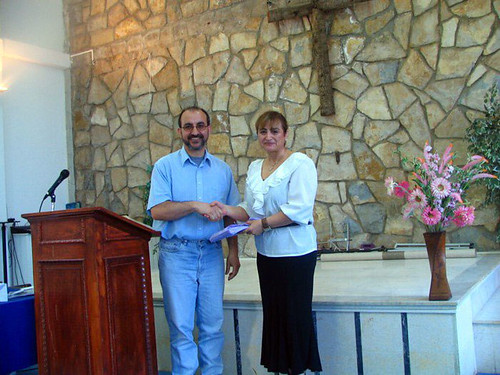
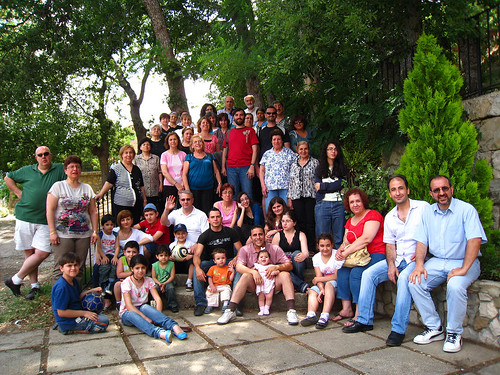
Photos courtesy of Nazani Svajian and Mano Chilingirian
On Friday, 24 June afternoon, the families, kids, young men and women, adults were in the church playground to head to the Arab Evangelical Camp center, in Dhour Shoueir. Ms. Vartoug Balekjian led the opening worship time. The guest speaker, Ms. Sonia Sislian presented the main theme of the retreat.
On Saturday, 25 June, the participants had their quiet time with God, after which they had worship time, led by Ms. Ani Baboghlanian.
The first session of the guest speaker entitled "To Love, to marry and ... to divorce", that the marriage was between Adam and Eve, that God joins and Satan divides. The subject was discussed further in 4 groups.
After having lunch, the second session was entitled "To Love, to Marry and ... to Renew our Vow with Christ", that Christ is the church's groom, He loves us greatly.
After dinner, Mr. Manoug Ibitian and Mr. Anto Ovigian led the social and fun time, as well as Armenian sing songs.
On Sunday morning, the worship time was led by Mr. Levon Bedigian. After having lunch and taking group photos, we headed back to the premises of the Armenian Evangelical Emmanuel Church.
The organizing commitee members were: Ms. Vartoug Balekjian, Mr. Manoug Ibitian, Ms. Ani Baboghlanian, Mr. Sam Demirjian.
The leaders of the discussion groups were: Ms. Vartoug Balekjian, Mr. Manoug Ibitian, Ms. Houry Barsoumian, Mrs. Vera Svajian.
Present were 38 members and 11 children.




































Photos courtesy of Nazani Svajian and Mano Chilingirian
Haigazian University Launches the 31st Volume of the Haigazian Armenological Review
On June 22 Haigazian University launched the 31st volume of the Haigazian Armenological Review.
 Father Antranig Granian, the editor-in-chief of the Review, highlighted the need for an accessible grand library that enables the researcher to save time and have at his finger tips the sources he needs for his comprehensive research. Fr. Granian noted that such a grand library could be established through the internet and website and called the audience to pay attention to the editorial of the current volume of the Review, which accentuates the need of such a website and everything pertaining to Armenian Studies.
Father Antranig Granian, the editor-in-chief of the Review, highlighted the need for an accessible grand library that enables the researcher to save time and have at his finger tips the sources he needs for his comprehensive research. Fr. Granian noted that such a grand library could be established through the internet and website and called the audience to pay attention to the editorial of the current volume of the Review, which accentuates the need of such a website and everything pertaining to Armenian Studies.
The Haigazian Armenological Review was started in 1970 and has since provided the invaluable service of offering an annual forum for Armenologists from around the world. The HAReview is a bridge between Armenologists in Armenia and abroad. Its aim includes the promotion of original and unpublished research and scientific work in linguistics, literature, bibliography, history, culture, arts, medieval studies, social sciences, Christianity and international relations. Its international contributors hail from France, the UK, North and South America, Armenia and the Middle East and have included numerous important academics in the field. The HAReview is a multilingual, yearly publication which allows its authors to publish in one of four languages (Armenian, English, French and Arabic).
Editorial Board member Armen Urneshlian welcomed the audience and noted that for the last twenty years the Review has been issued punctually on a yearly basis and has been an occasion for men of letters and concerned individuals to gather. Mr. Urneshlian noted that the Review is well recognized and respected both in the Armenian Republic and the Diaspora due to set guidelines and principles which have to do with the definition of Armenian Studies, the age diversity of the contributors, the plurality of views and the scientific approach. Mr. Urneshlian reminded the audience that the bibliography of the 30 volumes of the Review has been published lately and is on the Haigazian University website too. Mr. Urneshlian announced that on the occasion of the 500th anniversary of the publication of the first Armenian book, the Editorial Board plans to compile a bibliography of Armenian books published in Lebanon. He welcomed all those who could help in this regard.
The guest speaker, Dr. Vartan Matiossian, assessed the record of the Review over the past forty years. He noted that delving into Armenian studies is a complex responsibility as it is the study of “an area and a people that existed even before the time of Sumer and has continued its historical existence till now. It is the study of the past and present of this area and people with a vision to the future,” and added that “we want to know who and where we were, who and where we are currently, and who and where we will be in the future.” Dr. Matiossian noted that the Review is one of the five Armenian Studies periodicals of the Diaspora that features research papers in Armenian and appreciated both its timely publication and its comprehensive approach to Armenian Studies. Furthermore he underlined the fact that for the last two decades the Review has been particularly committed to a multidisciplinary approach in its choice and assessment of articles.
Dr. Matiossian stressed that we cannot allow ourselves the luxury of conflict between classicists and modernists, as is frequently seen in Western scholarship, and that Armenian studies offer a continuous and overlapping record at multiple levels and in many disciplines with no time limitations. As an example, Dr. Matiossian referred to the table of contents of the 31st volume of the Review, underlining the diversity of disciplines, topics, contributors and timelines encompassed in the volume. Dr. Matiossian categorically rejected all attempts at politicizing Armenian studies and turning it into some kind of overarching field of national-strategic interest. He stressed that the current “witch hunt” carried out in some circles promises “no good at all” and that any definition of Armenian studies compartmentalized into “Armenian,” “European,” “American,” and so on is indeed groundless and divisive. Dr. Matiossian appreciated the outlook shown by the Editorial Board of the Haigazian Armenological Review and called for a more open, pluralistic and tolerant approach in Armenian studies.
 Father Antranig Granian, the editor-in-chief of the Review, highlighted the need for an accessible grand library that enables the researcher to save time and have at his finger tips the sources he needs for his comprehensive research. Fr. Granian noted that such a grand library could be established through the internet and website and called the audience to pay attention to the editorial of the current volume of the Review, which accentuates the need of such a website and everything pertaining to Armenian Studies.
Father Antranig Granian, the editor-in-chief of the Review, highlighted the need for an accessible grand library that enables the researcher to save time and have at his finger tips the sources he needs for his comprehensive research. Fr. Granian noted that such a grand library could be established through the internet and website and called the audience to pay attention to the editorial of the current volume of the Review, which accentuates the need of such a website and everything pertaining to Armenian Studies.Finally Fr. Granian called on the audience to take the pleasure in reading the 31st volume.
In his closing message Haigazian University President, Rev. Dr. Paul Haidostian, welcomed the gathering on the occasion of the launching of the 31st volume of the Review, and thanked its editorial board and all those who contributed to its birth. Rev. Haidostian reiterated the necessity of preserving Armenian Studies in general as an appealing and important area for the young generations’ future education. Finally, Rev. Haidostian announced that soon Haigazian University would have its official Haigazian University Press registered at the Lebanese Ministry of Information.
At the end of the evening Rev. Haidostian, Dr. Matiossian and the editorial board cut the traditional cake.
The current 31st volume of the Haigazian Armenological Review is 764 pages. Attached you will find its table of contents and the editorial (both in English).
The volume will be on Haigazian University website in a week’s time.
Armenian Evangelical Bethel Church - Ministry Report 2010
Howard Karageuzian Foundation’s Visit to Haigazian University
 Beirut, July 20, 2011- On Monday, July 18, 2011, on the occasion of the Howard Karageuzian Foundation’s 90th Anniversary, a delegation of 20 social workers, headed by the Foundation’s Director, Rev. Robert Sarkissian, and including representatives and social workers of various Armenian foundations paid a visit to Haigazian University.
Beirut, July 20, 2011- On Monday, July 18, 2011, on the occasion of the Howard Karageuzian Foundation’s 90th Anniversary, a delegation of 20 social workers, headed by the Foundation’s Director, Rev. Robert Sarkissian, and including representatives and social workers of various Armenian foundations paid a visit to Haigazian University.The purpose of the visit was to express gratitude and thankfulness to those institutions which have cooperated with the foundation ever since its establishment in Lebanon 70 years ago, as it was pointed out by Rev. Sarkissian, who also highlighted the beneficial relations between the Howard Karageuzian Foundation and Haigazian University in particular. “Both institutions share the same vision and have the same mission of serving the Armenian and local communities, each in its own domain”, Sarkissian noted.
Haigazian University President, Rev. Dr. Paul Haidostian shared with the visitors the importance of the “social work” major at Haigazian University. “We are providing our best in preparing social workers and funding this major, yet, our best is much less than what our community needs”, Haidostian stated.
 Mr. Serop Ohanian, a Haigazian graduate, who will succeed Rev. Sarkissian, was introduced to the audience who shared some reflections as being a Haigazian University student and thanked Rev. Sarkissian for being his mentor for the past nine years.
Mr. Serop Ohanian, a Haigazian graduate, who will succeed Rev. Sarkissian, was introduced to the audience who shared some reflections as being a Haigazian University student and thanked Rev. Sarkissian for being his mentor for the past nine years.Mira Yardemian
Public Relations Director
Mr. Varouj Mazmanian Preaching and Visiting Emmanuel Church
Pope may go online to launch Vatican news portal
Associated Press
VATICAN CITY: The Vatican, whose communications problems are no secret, is taking a leap into the world of new media with the launch next week of a news information portal that Pope Benedict XVI himself may put online with a papal click.
Vatican officials said Saturday that Benedict has been following the development of the portal, which will for the first time aggregate information from the Vatican's various print, online, radio and television media in a one-stop-shop for Holy See news.
The portal, www.news.va, is being launched Wednesday, the 60th anniversary of Benedict's ordination as a priest and a feast day in the church.
Monsignor Claudio Maria Celli, who heads the Vatican office that developed the portal and will maintain it, said Benedict may put the site online himself with a click from the Apostolic Palace.

Monsignor Claudio Maria Celli shows to journalists the new portal, www.news.va, during a press conference at the Vatican, Saturday, June 25, 2011. The Vatican, whose communications problems are well known, is taking a leap into the world of new media next week with the launch of a news information portal that Pope Benedict XVI himself may put online with a papal click.
There are no search functions on the portal or an obvious link to the Vatican's main home page, but that may come in an update of the site, officials said.
VATICAN CITY: The Vatican, whose communications problems are no secret, is taking a leap into the world of new media with the launch next week of a news information portal that Pope Benedict XVI himself may put online with a papal click.
Vatican officials said Saturday that Benedict has been following the development of the portal, which will for the first time aggregate information from the Vatican's various print, online, radio and television media in a one-stop-shop for Holy See news.
The portal, www.news.va, is being launched Wednesday, the 60th anniversary of Benedict's ordination as a priest and a feast day in the church.
Monsignor Claudio Maria Celli, who heads the Vatican office that developed the portal and will maintain it, said Benedict may put the site online himself with a click from the Apostolic Palace.

Monsignor Claudio Maria Celli shows to journalists the new portal, www.news.va, during a press conference at the Vatican, Saturday, June 25, 2011. The Vatican, whose communications problems are well known, is taking a leap into the world of new media next week with the launch of a news information portal that Pope Benedict XVI himself may put online with a papal click.
"This is a new way of communicating," Celli said during a preview of the site at the offices of the Pontifical Council for Social Communications.
It's the latest effort by the Vatican to bring its evangelizing message to a greater, Internet-savvy audience and follows its forays into Facebook, Twitter and YouTube.
It's also a significant step for the 84-year-old Benedict, who has been bedeviled by communications woes during much of his six-year papacy, much of it the fault of a large Vatican bureaucracy that doesn't always communicate well internally.
There was his 2005 speech about Islam and violence, his recent comments about condoms and HIV that required no less than three official Vatican clarifications, and his rehabilitation of a Holocaust-denying bishop, among others.
While the portal is designed mostly to provide Vatican news in an easy-to-use setting for the outside world, Celli said he hoped it would also improve the Vatican's own internal communications by letting various departments know what one another are up to and help provide a more coherent message.
"I think that we must educate the Roman Curia of what is the real meaning of communication," Celli said. "Little by little they will perceive that this is the real meaning to be present, to have a relevance." Previously, popes have been very much involved in the Vatican's communications efforts: Pope Pius XI personally inaugurated Vatican Radio in 1931, and Pope John Paul II oversaw the 1995 launch of the Vatican's website.
That site will remain as the Holy See's main home page and documentation warehouse. And each of the Vatican media that are represented on the news portal will retain their independent sites as well: Vatican Radio, the newspaper L'Osservatore Romano, Vatican Television Center, the Vatican press office and information service and the Fides missionary news agency.
The portal, though, will aggregate their main news, initially in English and Italian then other languages, and be updated three times a day, Celli said. The portal is outfitted for live-streaming of papal events, audio feeds from Vatican Radio, photographs from L'Osservatore Romano and printed texts of papal homilies, statements and speeches.
It's also designed to be social-media friendly, with Twitter feeds and Facebook links, part of the Vatican's recent realization that it can reach a wide new audience by interacting with the outside world rather than merely preaching from afar.
An Interview with Hagop Akbasharian and Betty Kechejian About Their Participation in the Exchange Program with Christian Action in Orient (ACO) France
For the 2nd time now, four youth participated in the exchange program between UAECNE (Union of the Armenian Evangelical Churches in the Near East) Lebanon and ACO (Christian Action in Orient) France. Mr. Hagop Akbasharian (student of the UAECNE), Mr. Jiro Ghazarian (student of the UAECNE), Ms. Aline Khederian (chanitz member of the Armenian Evangelical Church of Nor-Marash), Ms. Betty Kechejian (chanitz member of the Armenian Evangelical Church of Ashrefieh) participated. On this occasion and in order to further understand about the program and their experience, we approached the four participants and thankfully we received responses from both Hagop and Betty.
Raffi - Can you tells us about this exchange program, who the organizers are and where it is taking place?
Hagop - This exchange program is part of the partnership between the Union of the Armenian Evangelical Churches in the Near East (UAECNE) and Christian Action in Orient (ACO) which takes place once every few years (usually four years). It is an exchange program between youth from Lebanon who attend member churches of UAECNE and youth from France who are members in ACO.
Raffi - What is the purpose of this exchange program?
Hagop - Usually, French participants come to Lebanon, specifically kchag, for ten days to be acquainted with the Lebanese-Armenian culture, experience the way Christian believers live their faith in the Middle East in general and in the churches of UAECNE in particular, do some social/practical work and enjoy the touristic areas of Lebanon, its food and good mood. The following year, the Lebanese participants of the first part of the exchange would go to France, mainly Alsace, Strasbourg for the same reasons mentioned above.
Raffi - What kind of subjects did you discuss in last year's exchange program?
Hagop - During last year’s exchange program we discussed about “Laicity” in France and the situation of the Church in Lebanon, especially the presence of the Armenian Evangelical Church in the Lebanese reality; moreover, we had discussions about sexuality, premarital and extramarital sex, culture and its influence within church dogmas and practices. The growing number of Muslims in France was also a topic that was present in various conversations.
Betty - We discussed many things, from spiritual topics to social ones. We discussed whether church attendance is important for a good spiritual life, also about relationships and what's acceptable in each society. About marriage and their view about it - all of these discussions were informal ones between a few people, not a formal group discussion.
Raffi - What are the differences that you perceived between the convictions and mentality in Lebanon and France?
Hagop - Individuals within the same country think and act in different ways; thus, it’s very normal and expected that an exchange program between different countries will experience differences in perspectives, convictions and belief systems. The differences that I observed were mainly that of culture and the role of the Church in society; however, in my opinion, these differences were not huge ones because similar differences are observed within different groups in our Lebanese community too; hence, these differences don’t hinder human relationships, but challenge human beings to think outside their boxes and personal bubbles. Whenever convictions are challenged, human interactions go from superficiality into a deeper level of mutual understanding. It is at that stage of relating to the other where a real exchange of thought and faith in God happens; consequently, faith enters the process of seeking understanding. If these kinds of exchanges between youth have even the slightest influence in triggering this process of understanding, then it can be called a successful exchange.
Betty - There are many obvious differences between French and Lebanese mentalities. The most obvious one is about relationships and what's "acceptable" in relationships. for them faith and sexuality don't have to be against each other. For us abstinence is very important.
Other than that, they are more laid back in nature, and don't stress as much as we do, which has to do with political issues and lifestyle differences. Oh and they're more open to talk about things. Topics which we consider taboo to discuss are ok for them to talk about.
Other than that, they are more laid back in nature, and don't stress as much as we do, which has to do with political issues and lifestyle differences. Oh and they're more open to talk about things. Topics which we consider taboo to discuss are ok for them to talk about.
The Banquet of the Armenian Evangelical Emmanuel Church
On Sunday, June 12 - the banquet of the Armenian Evangelical Emmanuel Church took place in the kingdergarten hall of the Armenian Evangelical Torosian Intermediate School. Mr. Mano Chilingirian was emcee. After welcoming everyone, the pastor prayed for the food and the gathering.
Several people had input in the program: Ms. Maral Khoshafian played on the piano, Mr. Garoudj Aroyan recited a poem, Mr. Sam Demirjian led the riddle games, Mr. Mano Chilingirian led the "Don't Forget" game. A word of thanks goes to the Khnamagal Marmin, the ladies who prepared the food, and those who contributed their gifts to the "Lo". There were 101 guests.

































Photos courtesy of Nazani Svajian
Several people had input in the program: Ms. Maral Khoshafian played on the piano, Mr. Garoudj Aroyan recited a poem, Mr. Sam Demirjian led the riddle games, Mr. Mano Chilingirian led the "Don't Forget" game. A word of thanks goes to the Khnamagal Marmin, the ladies who prepared the food, and those who contributed their gifts to the "Lo". There were 101 guests.

































Photos courtesy of Nazani Svajian

